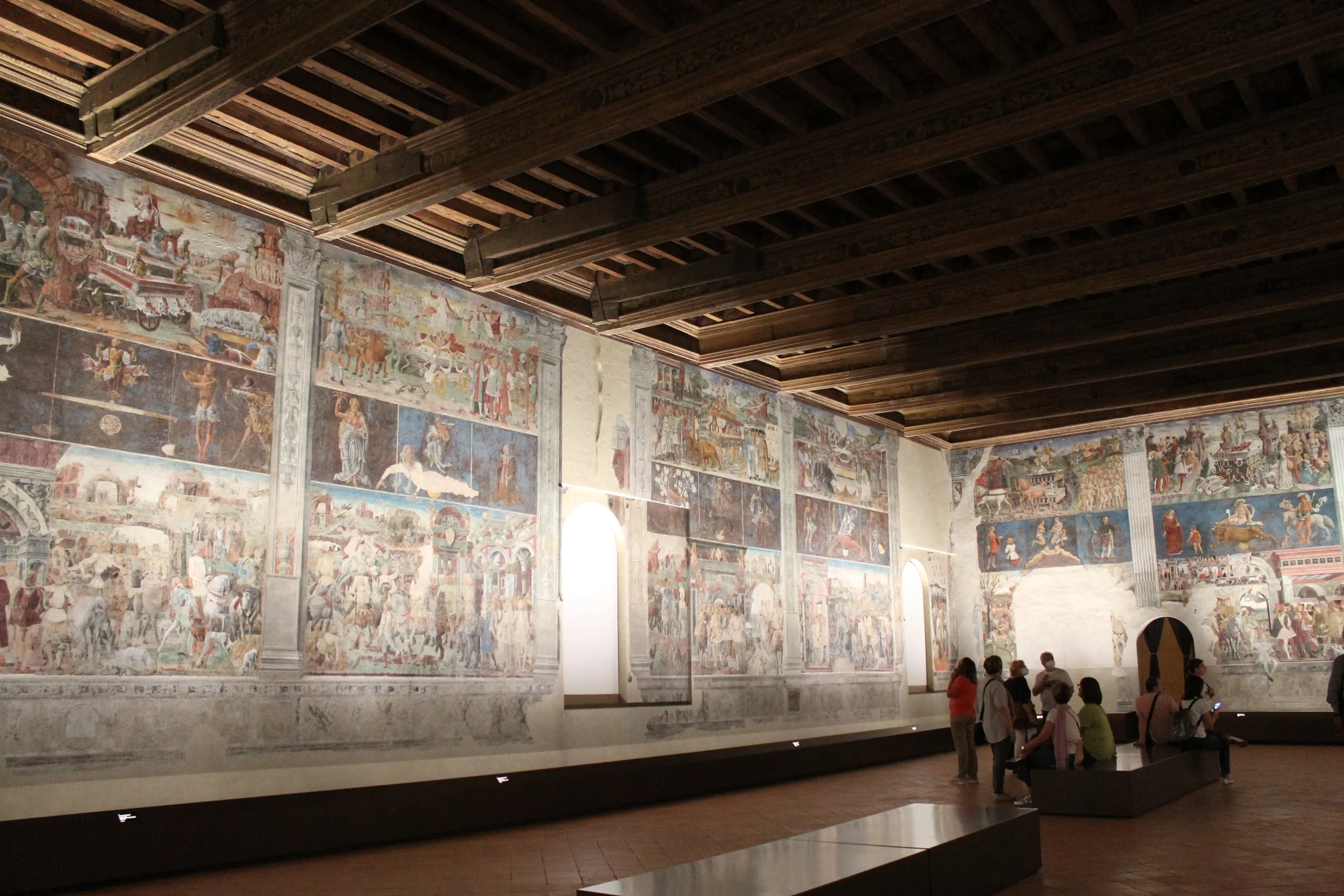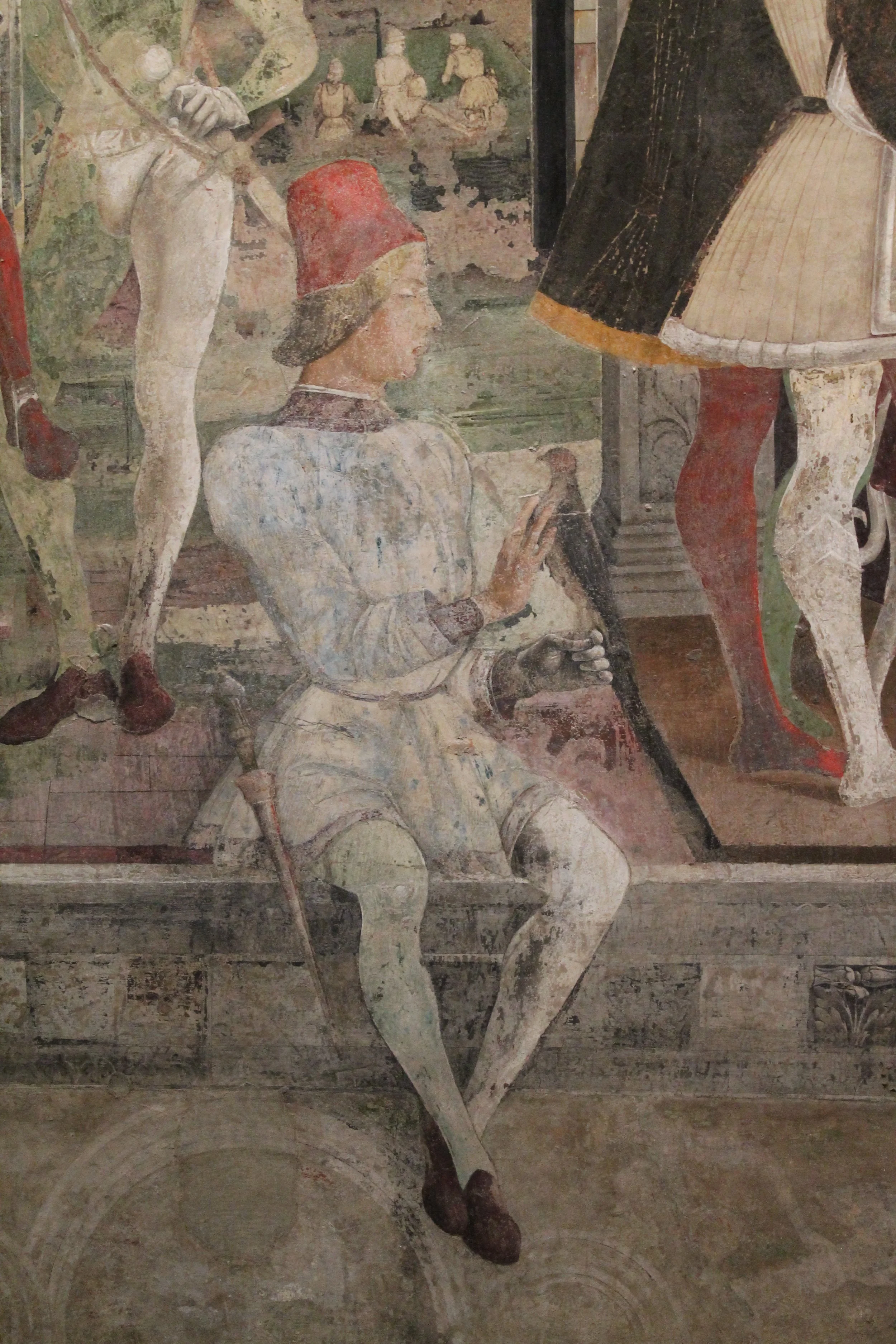Palazzo Schifanoia: From Renaissance Court to the Roma Today
Left: Month of April, Palazzo Schifanoia, c.1469-70 (Image: Google Arts & Culture). Right: Małgorzata Mirga-Tas, Re-enchanting the world, Venice Biennale, 2022 (Image: whitewall.art)
In Palazzo Schifanoia in Ferrara lies one of the most significant 15th-century fresco cycles in Italy; namely, The Hall of the Months. The high walls of the palace room are divided in 12 sections (one for each month), although today only the months from March to September survive. Created by a variety of artists from the school of Ferrarese court painter Cosimo Tura between around 1469-70, each month is divided into three horizontal bands:
Upper band: the World of the Gods (chariots transport different pagan gods, surrounded by ordinary or mythological scenes)
Middle band: space between humans and Gods (Western and Egyptian personifications of zodiac signs, emphasising the value placed on astrological ‘science’ at the court of Duke Borso d’Este at the time)
Lower band: the World of Humankind (activities of people in the court and city life, including the fresco cycle’s patron, Duke Borso)
(Image: iGuzzini)
(Image: Esme Garlake)
The palazzo was first built by the Este family (the ruling dynasty in Ferrara) around 1385-91 as a suburban retreat; its name ‘Schifanoia’ literally means ‘escape boredom’ (‘schifar la noia’). It was only decades later, however, that the building was expanded under Borso d’Este, who reigned as Marquis, and later Duke, between 1450-71. Along with architectural expansions, Borso commissioned leading local artists (generally agreed to be Francesco del Cossa and Cosimo Tura, with limited participation by Ercole de’ Roberti and other anonymous artists) to create The Hall of the Months fresco cycle. The iconography brought together antique wisdom, a celebration of local politics and city life and astrology. The allegorical language of the fresco cycle is highly complex and intricate, which has led historians to believe that it came from the immediate intellectual circle of Borso d’Este, perhaps with input from the court librarian and astrologer, Pellegrino Prisciani, and with details taken from 12th-century Italian writer Boccaccio’s 1360 Genealogia deorum (On the Genealogy of the Gods of the Gentiles). Since Borso had received little formal education, he tried to associate himself with artists and scholars of the time to promote his own image as a successful and erudite ruler.
(Image: Esme Garlake)
(Image: Esme Garlake)
(Image: Esme Garlake)
The entangled iconographies of The Hall of the Months challenge possible misconceptions of Italian Renaissance artworks as being either religious or classical in subject-matter. The frescoes not only bring together mythological and astrological figures, stories and symbols from different parts of the world (not only ancient Greek or Roman, but also from Indian, Persian and Egyptian), they also offer secular insights into court life and everyday life in 15th-century Ferrara; from washerwomen and labourers, to falconers and musicians. It is a cycle which celebrates variety, imagination and lived experiences.
For contemporary Polish-Roma artist and activist, Małgorzata Mirga-Tas, The Hall of the Months offers a unique source of inspiration. Her current installation Re-enchanting the World at the Venice Art Biennale 2022 draws on the cyclicity, allegories, and cross-cultural symbolism in The Hall of the Months, inscribing it with a specific Polish-Roma vernacular, and creating a ‘manifesto on Roma identity and art’. Perhaps most excitingly, this project marks the first time in the history of the Venice Art Biennale that a Roma artist is representing a national pavilion (despite the fact that the Roma constitute Europe’s largest minority).
The installation is made up of 12 large-format textiles. Just as in the Palazzo Schifanoia frescoes, each month is split into 3 bands:
Upper band: the mythical journey of the Roma to Europe (through a decolonised interpretation of a 17th-century print series by prolific French printmaker Jacques Callot)
Middle band: an archive of Roma women’s histories (images of real women are combined with magic and astrology)
Lower band: everyday life (mainly in Mirga-Tas’ hometown Czarna Góra)
(Image: Tubadzin Design Community)
(Image: whitewall.art)
Co-curator Joanna Warsza explains in a recent video that ‘it is all hand-sketched, traced, imprinted and embroidered’. It was only when the 37 panels were finally installed on site that everyone, including the artist, could get a sense of the final effect. Warsza continues: ‘it is like a discovery for us now… what [the panels] mean together… [and] what kind of cyclicity they create.’
By entering into a dialogue with famed frescoes at Palazzo Schifanoia, Mirga-Tas ‘attempt(s) to find the place of the Roma community in European art history’. This is a significant and complex task in the face of an art history which has both excluded and co-opted Romani culture for centuries. Ethel Brooks, a contributor to the exhibition’s catalogue, has previously described how ‘the work of the Roma has often gone unrecognised, while the people themselves have been equally disregarded. Yet, as artists, intellectuals and activists, we Roma have generated extensive knowledge and created a vast array of cultural and artistic practices as part of a global legacy that has been co-opted and colonised by others – from individuals to nation states to entire continents.’ Re-enchanting the World offers a sort of Roma palace in Venice, creating a space in which visitors can learn about and celebrate Roma histories, cultures and identities. This comes only a few years after Romarchive was launched, a constantly growing digital archive for Romani arts and cultures. It offers ‘an internationally accessible space that renders Romani cultures and histories visible… [and provides] counter-narratives told by Roma themselves’.
Although Mirga-Tas works in many different mediums, her large-format textile (such as this installation), include fragments of fabrics ‘which often come from clothes once worn by people dear to the artist, such as family members and friends’. There is something intensely personal about the textile artworks, perhaps because it draws attention to (and often challenges) historical associations of sewing and crafts with domestic spaces. Ideas of folklore, oral histories, storytelling and familial relationships are all embedded in these associations of ‘private’ spaces. Contemporary American artist and writer Christopher Myers, who also creates large-scale textile pieces, has explained how his work ‘as a storyteller and as an artist centres on pulling mythologies apart from official records. Especially for African-Americans and other marginalised folks, we must learn to read these records for our unwritten histories, to see ourselves in the empty spaces on the page.’ The traditional association between textiles and femininity is also interrogated by Mirga-Tas’ varied and powerful female figures. In fact, the project’s title was inspired by Silvia Federici’s book Re-enchanting the World: Feminism and the Politics of the Commons (2018). The book grapples with ideas of community and how we can rebuild relationships with others, including non-human actors (such as animals, plants, water or mountains), a process in which women play a significant role.
Mirga-Tas’ Re-enchanting the World is a brilliant example of how artworks made over five hundred years ago remain sites of inspiration - and interrogation - today, particularly as a means of giving space to marginalised histories, voices and stories.










